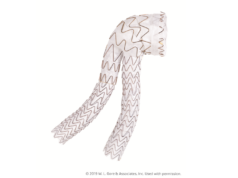
Results of a sub-study from the pivotal Investigational Device Exemption (IDE) trial assessing Gore’s Excluder conformable abdominal aortic aneurysm (AAA) endoprosthesis have shown that the device is safe and effective in hostile angulated neck anatomy, with the results maintained out to one-year.
Mahmoud Almadani, MD, from Maimonides Health in Brooklyn, New York, presented the new data during yesterday’s (Wednesday, June 19) William J. von Liebig Forum.
The analysis involved 95 patients who were enrolled in the IDE trial, a prospective, multicenter clinical trial conducted at 35 U.S. sites between January 2018 and February 2022. To be included in the high neck angulation sub-study, patients had to have an infrarenal aortic neck angulation of >60˚and ≤90˚with an aortic neck length ≥10mm.
Gore’s Excluder conformable AAA device first gained Food and Drug Administration (FDA) approval in late 2020, with an expanded indication for patients with aortic neck angulation ≤90° and a minimum length of 10mm approved last month (May 2024).
The device is comprised of a conformable stent graft with enhanced positioning and optional angulation control. It also includes a mechanism that, after the first stage of deployment, constrains the device to 70% of its full diameter, which is intended to allow for manipulation and angulation of the proximal end of the stent graft.
“The device was designed for high neck angulation,” Almadani said during his presentation. “Many of you in the audience have experience using this device in a high neck angle situation, and I will present the data to justify its use.”
Patients enrolled in the study had a mean age of 74 years old, were predominantly White and non-Hispanic, and were predominantly male, Almadani detailed, acknowledging this as one of the limitations of the study, but also that this represents the typical distribution of aortic aneurysm disease expected in this type of study.
In terms of the anatomic characteristics, Almadani noted that patients had a mean neck angle of 71˚, with a mean aortic neck length of 21mm. The most common comorbidities included hypertension, hypercholesterolemia and tobacco use.
Technical success–which was defined as a composite of successful access, deployment, removal of delivery catheters, patent and access site closure, and absence of site-reported type I or type III endoleak–was achieved in 97.9% of patients, Almadani reported, with two patients noted to have a type I endoleak at the completion of the procedure.
Freedom from the primary safety endpoint–a composite of procedural blood loss >1,000mL, death, stroke, myocardial infarction, bowel ischemia, paraplegia, respiratory failure, renal failure, and thromboembolic events–was achieved in 97.6% patients.
The primary effectiveness endpoint–a composite of technical success and freedom from a type I and III endoleak at 12 months, as well as migration of >1cm and sac enlargement >5mm between one and 12 months, AAA rupture and conversion to open repair through 12 months–was recorded in 94.8% of patients for whom data were available at one year.
“The Conformable IDE demonstrates the safety and effectiveness of the Gore Excluder Conformable device,” Almadani said in his concluding remarks. “This was also preserved at one year, and we believe this is a new frontier for safely treating high-risk aortic neck patients with an infrarenal sealing AAA device.”
During discussion that followed Almadani’s presentation, he was asked by session co-moderator Andres Schanzer, MD, on the “sweet spot” for the device, given other treatment options, including fenestrated grafts and endoanchors.
“I think this device is ideal in a situation where you have an anatomically high-risk patient, with a highly angulated neck, and you want to try to maintain an infrarenal seal zone without having to extend and manipulate the visceral vessels and place parallel stents or suprarenal stents,” Almadani responded.











